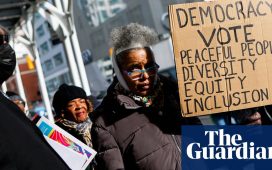Another 1.9 million Americans filed for unemployment benefits last week as the total number of claims passed 42 million since the coronavirus pandemic hit the US.
The pace of layoffs has slowed dramatically from its peak of 6.6m at the start of April as states start to relax quarantine orders and last week was the ninth consecutive week of declines. But the scale of layoffs remains staggeringly high. In the worst week of the last recession “just” 665,000 people filed for unemployment.
Jason Reed, professor of finance at the University of Notre Dame’s Mendoza College of Business, said the numbers may be coming down, but “this is unprecedented. The figures are so high that it’s hard to grasp the reality.”
On Friday the labor department will release May’s monthly jobs report. Economists are predicting unemployment will rise to close to 20% from 14.7% in April and some 8 million more jobs will have been lost after a combined drop of 21.4 million in March and April.
At 20% the official tally would mean one in five Americans in the workforce are now out of work. The layoffs have disproportionately hit African Americans, Latinos and those without a college education.
On Wednesday ADP, the US’s largest payroll supplier, said private sector companies had shed 2.8m jobs in May, a huge number but far less than the 8m analysts had expected.
The news cheered Wall Street and was taken by some as a sign that people were now returning to work after the lockdowns. But the report also contained worrying signals about future losses. Losses in leisure and hospitality jobs dropped sharply to 105,000, down from 7.5m in April, but there were large job losses in trade and transport (down 826,000 jobs) and manufacturing (down 719,000 jobs).
The Bureau of Labor Statistics is currently reassessing its measurements and Morgan Stanley economists warned this week that the “shadow” unemployment rate – which includes people not currently picked up by the official government figure – may be 25%.
“In reality, the shadow unemployment rate, which includes people absent from work for other reasons, is much higher,” Morgan Stanley wrote in a note.





